
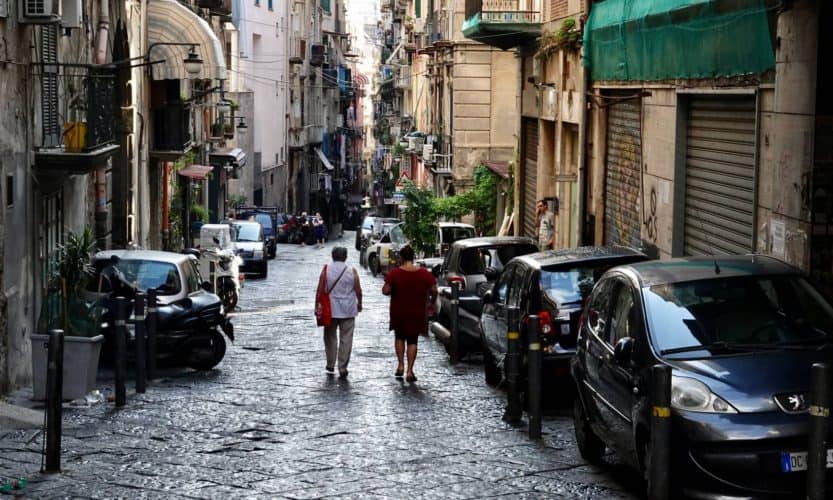
In the middle of a delayed, sweaty, overcrowded train ride from Naples Central Station to the archaeological ruins of Pompeii — somewhere around Torre del Greco — it dawned on me: maybe all the rumours about Naples are true.
It was my girlfriend and I’s first international trip together. After considering our options for a few days, we decided to head to the colourful Amalfi Coast. It looked like a destination that was romantic, relaxing, and reasonably priced. I had rarely been more excited to embark on an adventure.
Until I realised that the easiest way to get from Belgium to Amalfi without a car is flying into Naples.
Now, I had heard stories about Naples. How the city’s trash problem hadn’t been fixed in years. How nearly every building was covered in graffiti (and not the fun kind). And how the public transport was unreliable and inefficient — at best.
You may say Naples is the most unfiltered, gritty version of Italy you can find. And you may even believe that’s a good thing. But I don’t.
If you like Naples, good for you! I’m not trying to get you to dislike the city. It has wonderful places waiting to be discovered, the food is to die for, and the centuries’ worth of history hidden in the city are unfathomable.
All I’m saying is: it’s not a city that immediately enchants everyone.
To a small-town guy like myself, Naples feels a lot like the New York City of southern Europe. You feel like you just have to visit at some point, the place has plenty of things to do, and you need a few days to decompress when you get home.
The only way to find out whether the destination is worth your time is to give it a try.
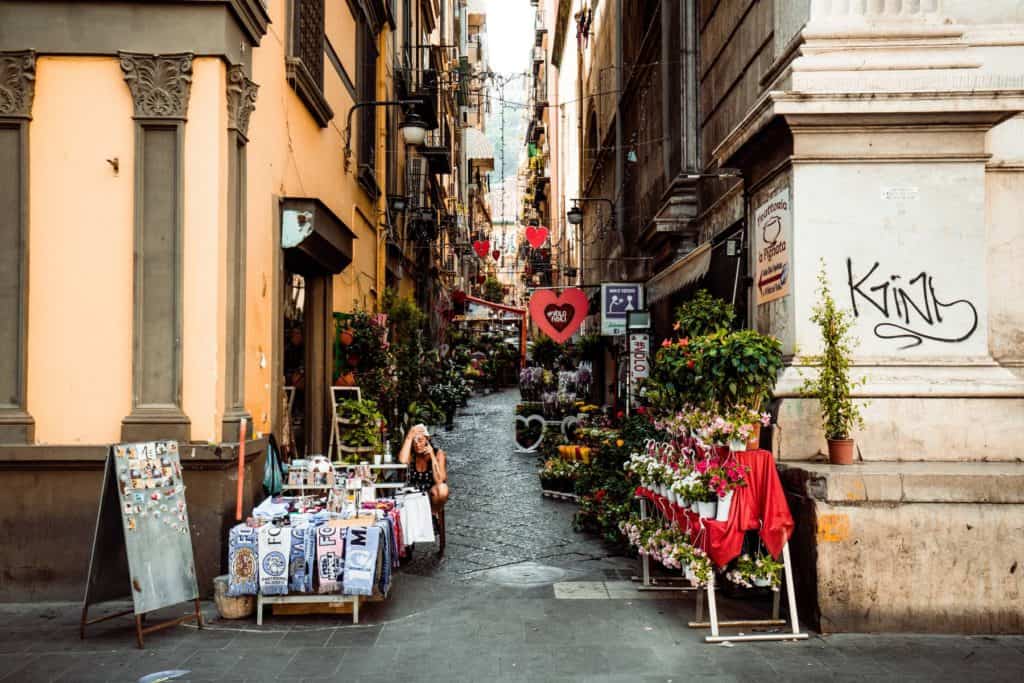
Reading this article may lead you to believe that I hated every minute of my time in Naples. But nothing could be further from the truth. After all, you can’t hate a city you’ve only spent two days in.
We decided to explore Naples before continuing to the Amalfi Coast. We were going to be passing through anyway, so why not slow down a bit and take a gander at the city?
As it turns out, two days was plenty of time to do everything we wanted to do in Naples. In short: walk around, eat and drink to our hearts’ content, and soak in the atmosphere.
One thing I liked about these two days is that we didn’t feel the need to cross off things from a list of “things to do in Naples”. This allowed us to spend quality time together without feeling anxious about missing out on certain experiences.
I’m sure we skipped a few things that would have been worth our time, but I don’t regret any of the decisions we made on this trip. I will look back on our time in Naples and remember the conversations we shared on a rowdy square and the dogs who came to say hi when we were having a drink.
And I wouldn’t have it any other way.
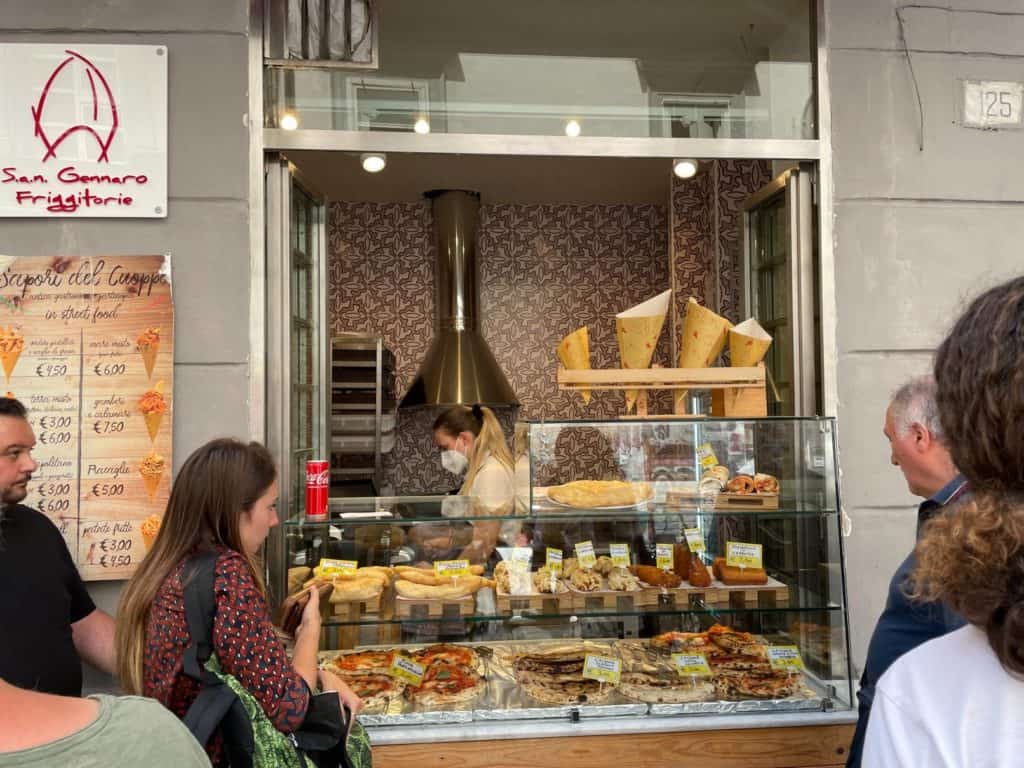
When you’re talking about the literal birthplace of the pizza, you’d better have a good reason for criticising the food.
Don’t get me wrong — some of the food we had in Naples was mouth-watering. We were blown away by the sfogliatelli, arancini, sgagliozze, crocchè, and other food with names that are tricky to pronounce for non-native speakers.
Remarkably, the one thing that disappointed us was the pizza. Maybe it’s because we were only there for two days and we didn’t venture far enough into the lesser-known depths of the city in pursuit of the perfect pizza napolitana. Or maybe it’s because we were anticipating a life-changing meal.
Either way — we expected more from a city known for its pizza.
We were told the best pizzeria in Naples was L’Antica Pizzeria da Michele. So, of course, we were more than happy to wait in line for 15 minutes before a middle-aged Italian man shouted my girlfriend’s name and handed us our dinner in the typical square cardboard boxes.
Again, don’t get me wrong: in terms of value for money, we got a deal that was hard to match. €5 for a pizza we both struggled to finish? Come on.
Could it be that I drew the wrong conclusion from this experience? That Naples does have life-changing pizza — and it’s just a matter of managing expectations?
Maybe Naples is a city that will grow on me with a second visit. Or maybe it’s just not my cup of tea. And you know what? I think that’s okay.
PIN IT!
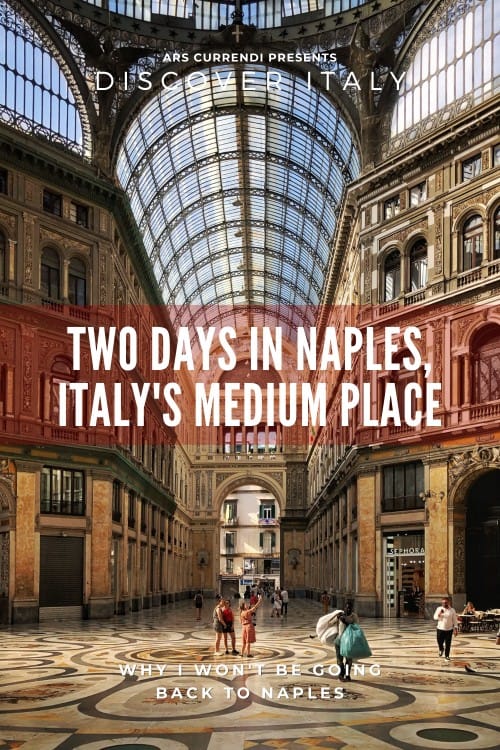
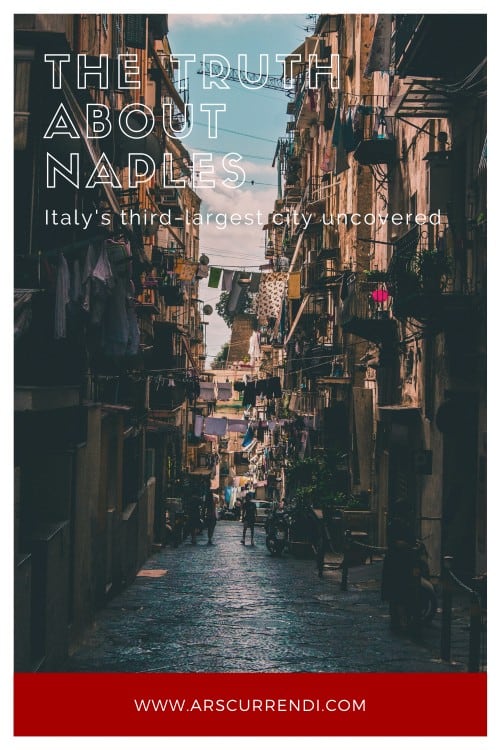
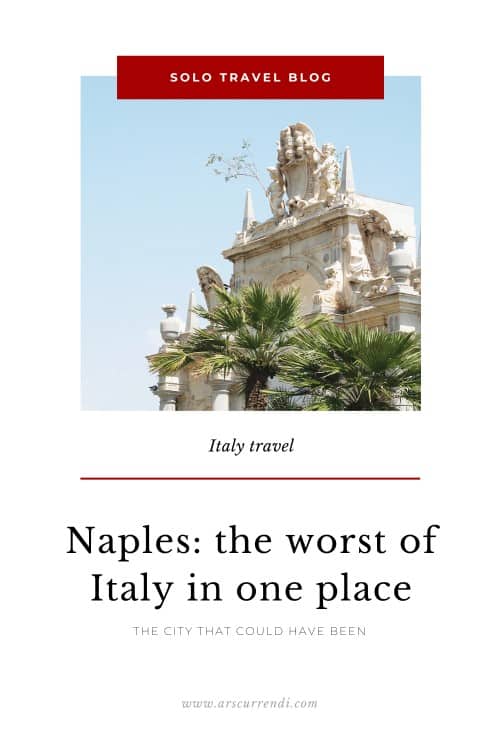
Photo credits
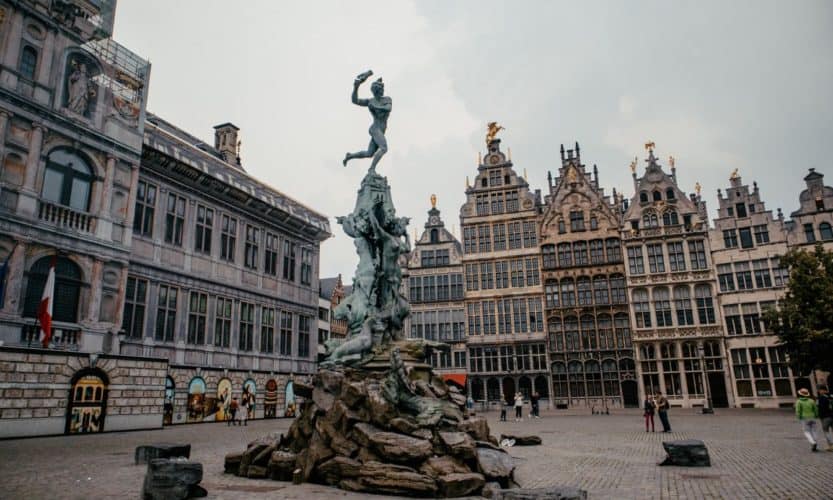
Are you visiting Belgium on a budget? Then you may be looking for the best free things to do in Antwerp. Fear not: a local — yours truly — is here to help. Antwerp is probably my favourite city in Belgium. Granted, I live here, so I may be a bit biased. But still: it’s undeniably an amazing city with great culture, history, nightlife, and restaurants. Are you ready to discover why I recommend visiting Antwerp to all my friends? Let’s jump in!

Before you start booking your train tickets or hostel rooms, there are a few things you should know about travelling to Antwerp.
First and foremost: if you intend to stay in Antwerp for two or more days, get an Antwerp City Card. It might seem a bit pricey, but this card will give you free entry to 16 major museums and plenty of other attractions worth your time. You’ll also get discounts all around the city and free access to public transport.
Buy the Antwerp City Card here.
Secondly: if you’re coming to Antwerp by train — and even if you’re not — don’t forget to admire Antwerp Central Station. It’s often mentioned in “Most beautiful train stations in the world” lists, and for good reason.
Lastly: Antwerp is one of the culinary hotspots in Belgium. Don’t let the extensive list of amazing restaurants in Antwerp pass you by.
Are you a visual learner? You’ll find each of my favourite free things to do in Antwerp on this interactive map.
(Is the map not loading properly? Try this link.)
Whether you’re looking for a new coffee table book, a present for your sister’s birthday, or a fun way to spend a few hours — there are plenty of independent bookstores in Antwerp worth your time.
Some of my personal favourites:
If you’re as much of a literary nerd as I am, you’ll appreciate this article about the best independent bookstores in Antwerp.
Joining a free walking tour is one of the best ways to get to know a city. That’s no different in Antwerp.
Legends Tours organises tours with knowledgeable, English-speaking guides every day at 10:30 AM, 1:30 PM, and 8 PM. They’re rated #1 on TripAdvisor, and for good reason.
If you’re looking to join a tour, just book a spot on their website and come to the Grote Markt at your designated time slot.
After wandering through a narrow, cobbled alley, you’ll find yourself at the beautiful Hendrik Conscienceplein — unsurprisingly named after Flemish 19th-century writer Hendrik Conscience.
This square is home to St. Charles Borromeo Church, which is often called the most important baroque church in the Low Countries.
Thanks to the many cafés and restaurants and the street performers who also frequent the square, it’s one of the locals’ favourite places to hang out on sunny afternoons.
My personal favourite bar around this square is called De Zwaan — just so you know.
Antwerp is not only home to the second-largest seaport in Europe, but it’s also where you’ll find five monumental churches within walking distance.
*: Admission to the Cathedral of Our Lady is €8 (€6 for students and over-60s). Admission to St. Paul’s Church is €5 (€3 for students), but free every first Tuesday of the month. Both churches are free if you have an Antwerp City Card.
Each of these churches has a unique personality and story. And, perhaps more impressively in this day and age, they all still host vibrant Catholic communities.
One of the first things I discovered when I moved to Antwerp was the Kloosterstraat, and I still love it.
Let me explain: this street has the perfect mix of vintage interior stores, trendy boutiques, and impressive art galleries. And, best of all, almost all these shops are open on Sunday.
The vibes are immaculate, and you’ll be sure to find a few gems in the window displays. To this day, heading to this street on the weekend is one of my favourite free things to do in Antwerp.
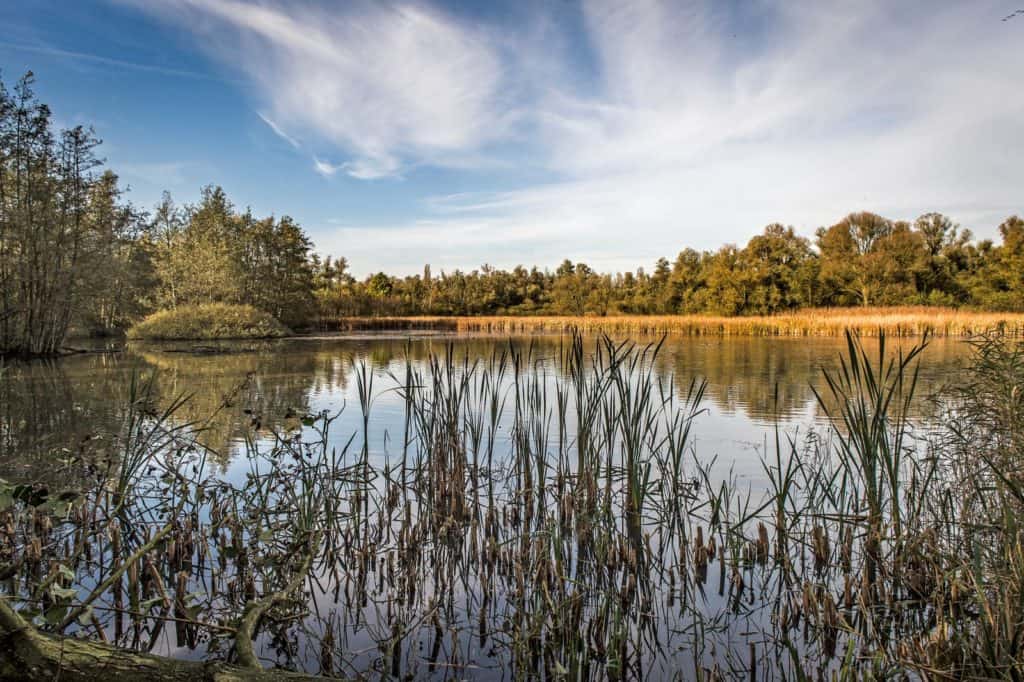
While travelling to the big city — yes, Antwerp is a big city in Belgium — little spots of nature can be a godsend. If you’re looking for a breath of fresh air and some greenery, take a look at the following parks:
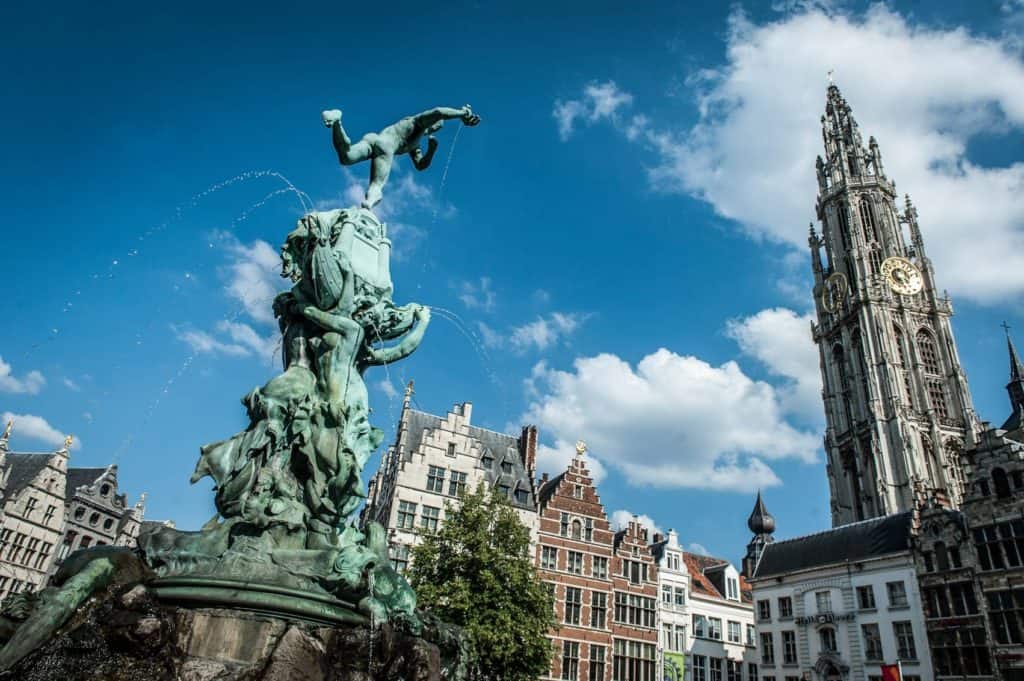
There’s no way you’re travelling to Antwerp without visiting the Antwerp essentials, right? You can cross the following sights off your bucket list in about 30 minutes, so you might as well give them a go.
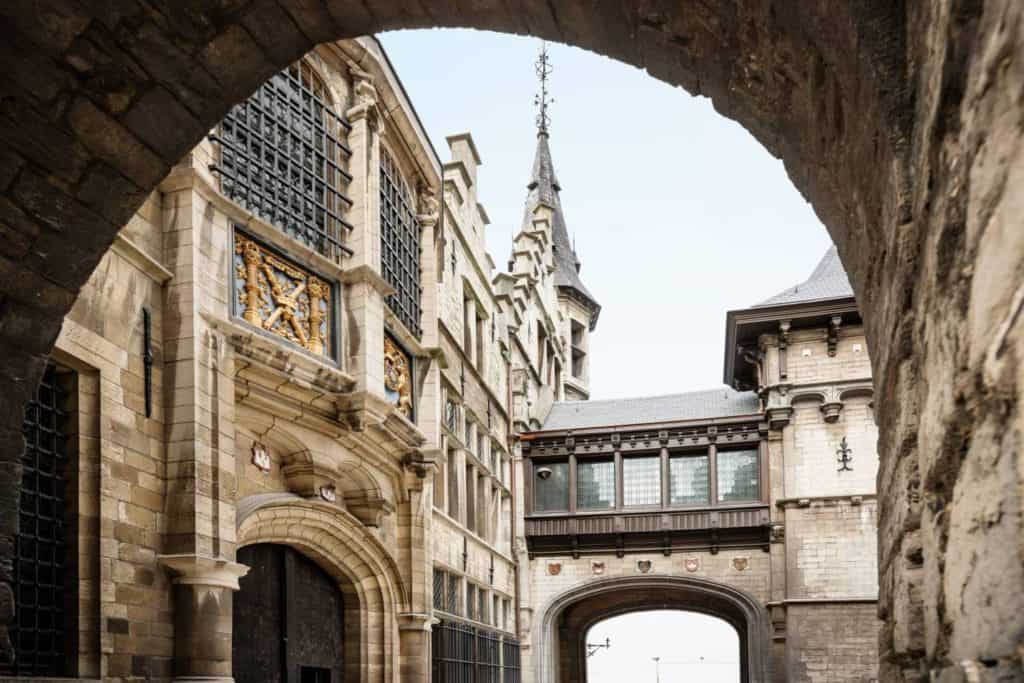
Cities in Belgium and the Netherlands are often said to transport first-time visitors and long-time residents alike back in time.
Whether that’s also the case in Antwerp, you ask? Why don’t you head down to the Beguinage, the Vlaeykensgang, and Het Steen* and find out for yourself? Or discover the secrets that the city’s sewers (also known as De Ruien*) have held since the Middle Ages?
Spoiler alert: it is, in fact, also the case in Antwerp.
*: Het Steen and De Ruien are not free to visit unless you have an Antwerp City Card.
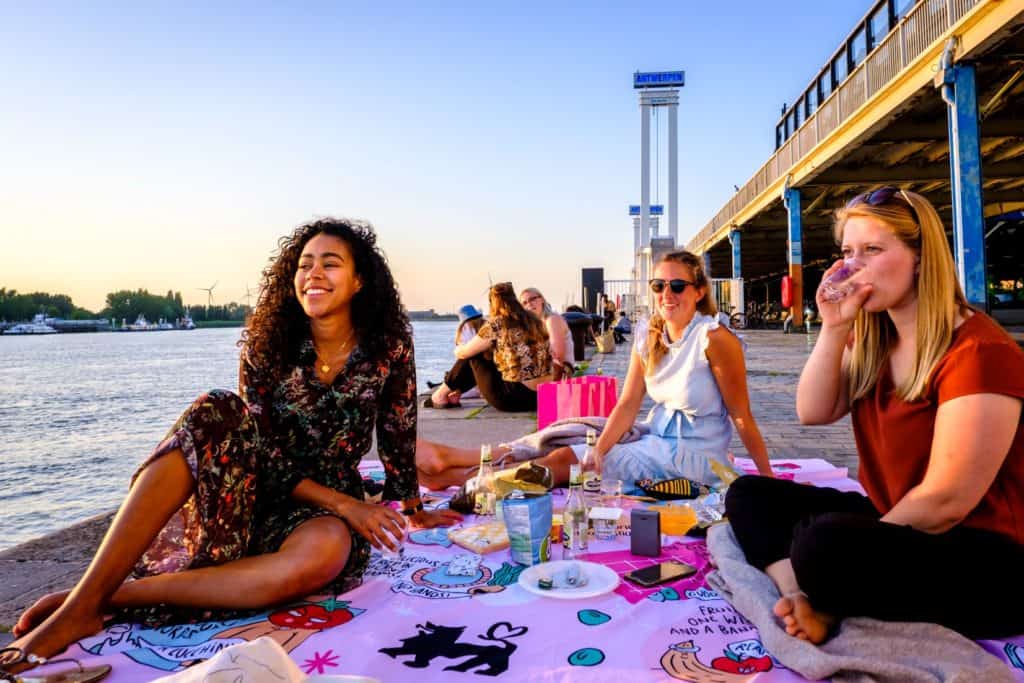
Down by the river, by the boats …
Well, if you’re looking for boats, there are better places to look than the riverside in Antwerp, but there’s still a great time to be had.
Start your afternoon at Het Steen with a walk along the river.
Gather your friends, get some snacks and cheap wine (or a non-alcoholic alternative) at the supermarket, and plump yourself down at the Scheldt Quays. Don’t get up before the sun sets — trust me.
I’ve been living in Antwerp for nine months at the time of writing this. That’s great news for me, because I love living here. But it’s also great for you. After all, I can now tell you all about the best restaurants around the city.
Vegetarian, Italian, Asian, or brunch — whatever you’re looking for, Antwerp has got you covered.
Most of my favourite places to eat and drink are in Het Zuid — the trendy neighbourhood in the south.
Discover the best places to get breakfast, lunch, dinner, and drinks around Antwerp:
When making a top-10 list of free things to do in Antwerp, there are bound to be some things that just don’t make the cut.
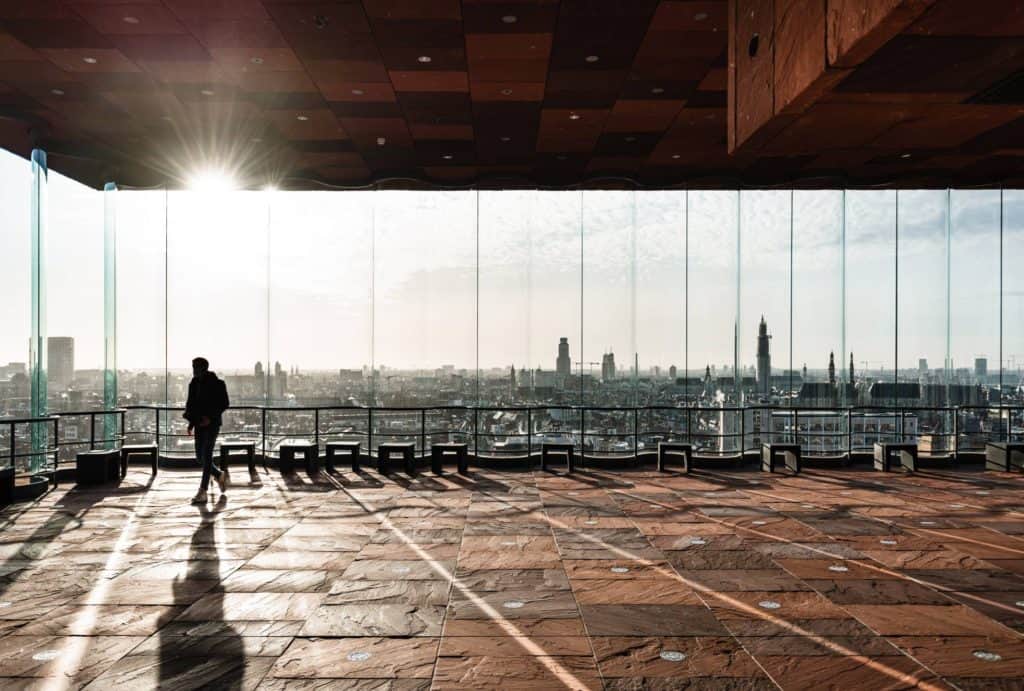
These are my honourable mentions — or, in other words, free things to do in the city if you have some time left over.
These were a few of my favourite free things to do in Antwerp — thanks for reading! Did I miss anything? Be sure to let me know in a comment.
PIN IT!
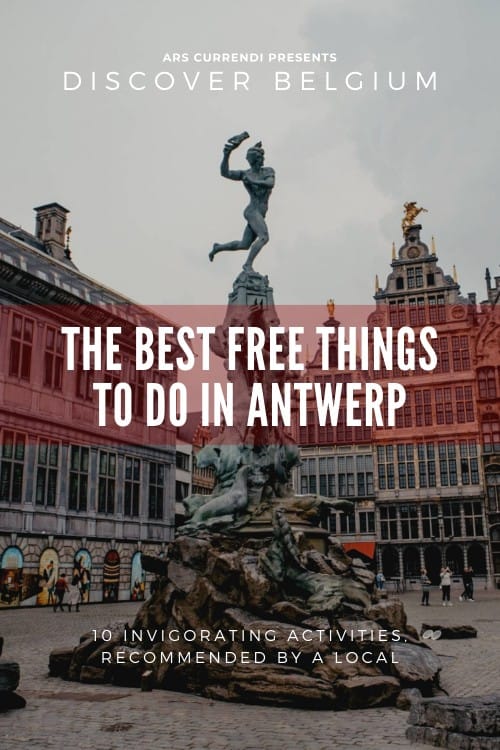
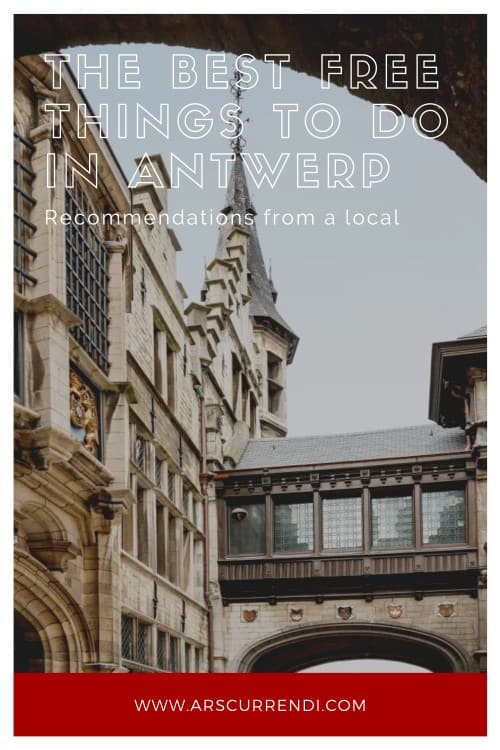
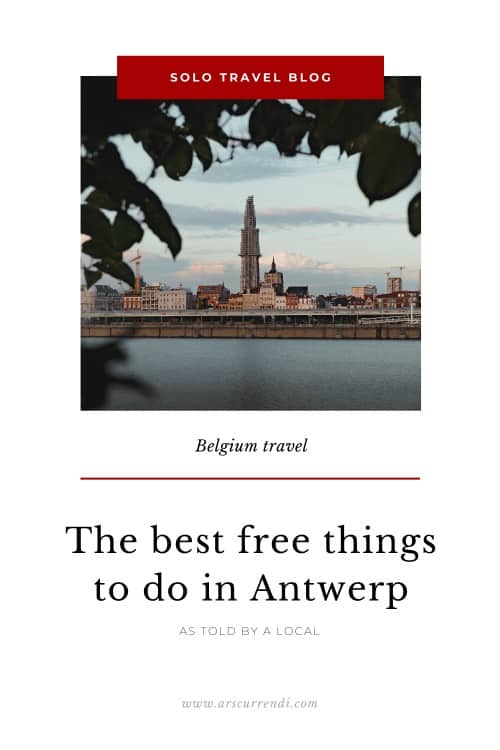
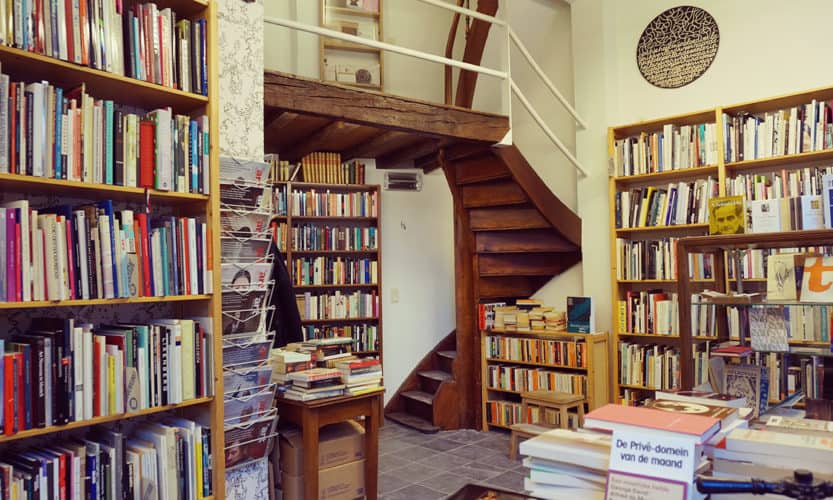
Antwerp is one of the main cities in Belgium, so it should come as no surprise that the city is home to several independent bookstores worth a visit. Whether you’re looking for a new coffee table book, a present for your sister, or the latest contemporary fiction, these bookstores in Antwerp will be sure to make your heart beat faster.
Note: The bookstores mentioned below are not presented in any particular order.
Before you go any further, take a look at the embedded map below to see all my favourite independent bookstores in Antwerp on a map.
If the embedded map isn’t working for you, check it out here: The 10 Best Independent Bookstores in Antwerp
For my favourite places to eat in Antwerp, check out this post:
Best Restaurants in Antwerp: The Ultimate Foodie Guide
Bookz&Booze is a unique concept bookstore in Antwerp that matches books with bottles — based on the book cover, the story, one of the characters, or another similarity between the two. How does a book about the Peaky Blinders TV series and a bottle of Sadler’s Peaky Blinder spiced dry gin sound to you?
The owners of Bookz&Booze are incredibly helpful and infinitely knowledgeable about their books and bottles. They love to tell you the story behind why they chose a particular bottle for one of their books.
You can purchase the books and drinks separately, and they’re perfect gifts for your loved ones.
Stad Leest is one of my favourite bookstores in Antwerp for the newest book releases. The inside of the store is massive — you could spend hours here and still not see everything — and the natural light makes your shopping experience all the more pleasant.
If you’re looking for a wide range of art and lifestyle books, children’s books, and contemporary fiction, Stad Leest is the place to be. It’s also one of the few bookstores in Antwerp with a considerable selection of English books, both fiction and non-fiction.
As if that’s not enough: there’s also an outlet store just around the corner, where you’ll find some absolute bargains.
International Magazine Store might not be a bookstore in the traditional sense of the word, but — as the name suggests — it’s a store dedicated to selling magazines. And trust me: that’s a lot more interesting than it may sound.
IMS has a vast selection of both domestic and international magazines, newspapers, and coffee table books (incidentally, one of my favourite types of books).
Whether you’re looking for the latest issue of Vogue, Condé Nast Traveler, or that vintage car magazine you keep telling your friends about — chances are you’ll find it here.
Panoply is one of the best second-hand bookstores in Antwerp, period.
At just a five-minute walk from what can only be described as the most beautiful square of the city — Hendrik Conscienceplein — you’ll find Panoply: a common townhouse transformed into a safe haven for used book hunters, record collectors, and solo travellers looking to pick up a hidden gem.
With its friendly and knowledgeable staff, I challenge you to leave this store empty-handed. (Spoiler alert: you’ll fail.)
De Groene Waterman is a bookstore that looks unassuming from the outside — but transports you to higher literary spheres when you enter.
With a comprehensive, eclectic collection of Dutch and English books — both fiction and non-fiction — you’ll be sure to find a book that will broaden your mind here. Prices are comparable to online retailers, so why not support a local store if you’re in Antwerp either way?
The best part about this particular bookstore? If you walk to the back, turn left, and go up the stairs, you’ll find the hidden bargains: books and magazines in great condition, sold at hefty discounts.
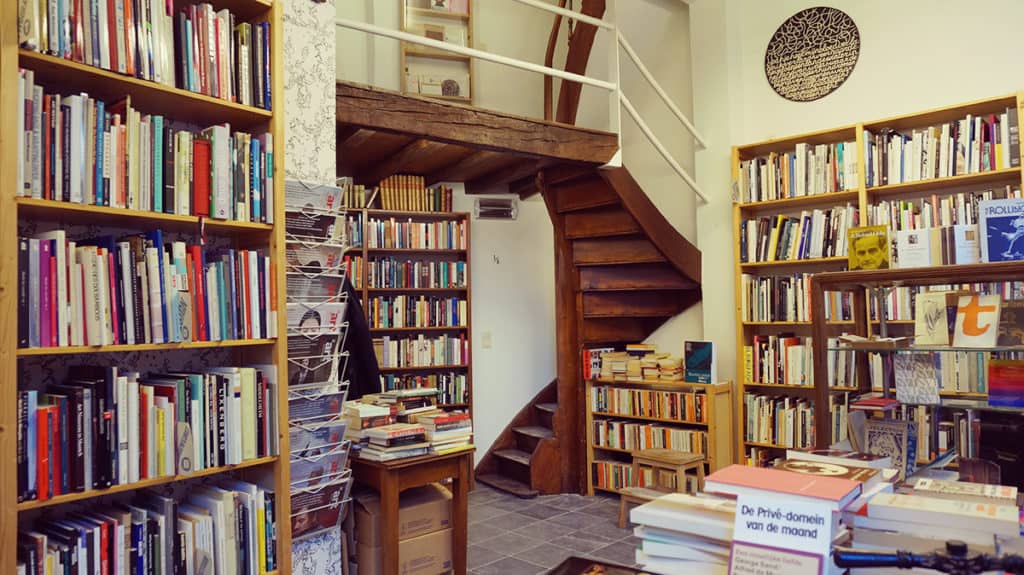
I walked into Demian on a sunny Saturday afternoon in November with no idea what to expect. What I found was a charming and well-stocked bookstore where the shelves are stacked with second-hand art and philosophy books, literary classics, and rare prints and manuscripts.
The owner, René Franken, has a tangible passion for all things literature and poetry. He mostly follows his own literary preferences when replenishing his stock, and he’s always ready for a stimulating conversation with his clients.
A special mention goes to the bookstore’s extensive collection of poetry on the mezzanine floor. Also worth mentioning is the upstairs room, where the owners regularly host literary exhibitions. In that upstairs room, you’ll find a permanent supply of valuable posters, photographs, invitations, manuscripts, and more.
I bought a 1966 copy of Joseph Heller’s Catch-22 at Demian for less money than that afternoon’s cup of coffee cost me, and I got René’s comments about this edition for free.
If you like books and wine, Luddites — pronounced luh-daits — will soon become one of your favourite bookstores in Antwerp. A beautiful building with high ceilings is home to this unique bookstore-slash-winery concept that saw the light of day in 2018.
Boasting Antwerp’s largest selection of English fiction and non-fiction books, stacked on floor-to-ceiling shelves, and a wine bar hidden upstairs, Luddites is Jorien Caers and Richard Bolte’s answer to the world that relentlessly keeps digitising.
There is no wifi available, so pick your poisons — a new book and a glass of exceptional, yet affordable wine — and unplug in the wine bar.
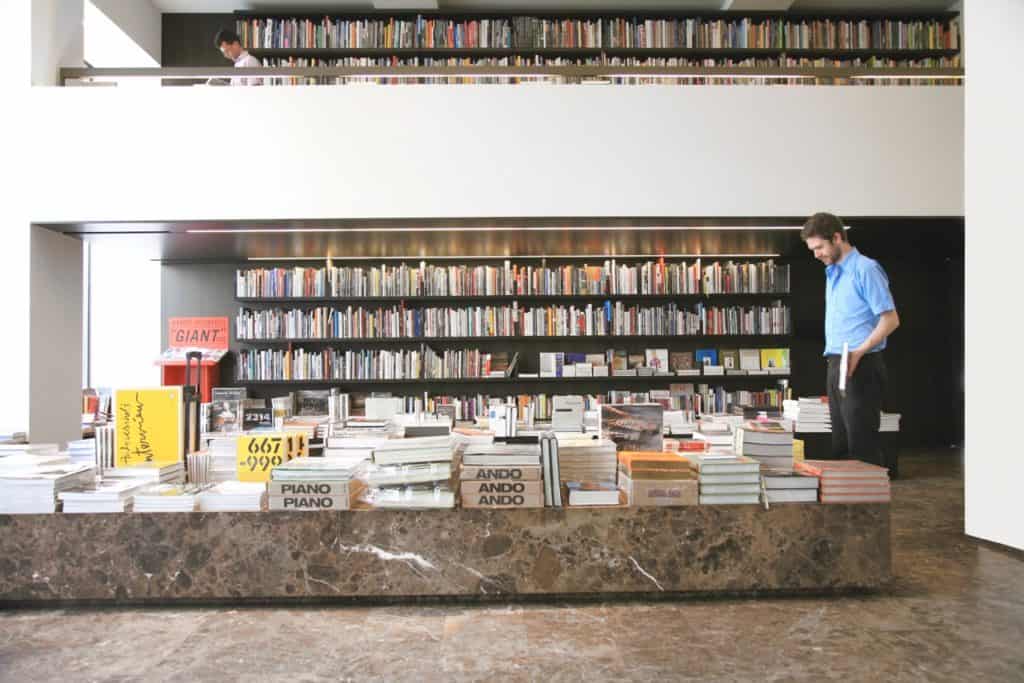
You don’t come to Copyright Bookshop to pick up the latest New York Times bestseller. You come here to enjoy the rich cultural heritage of the Belgian art and architecture scene.
The staff members are friendly and act as ambassadors of that Belgian history, with precision, respect, and sincere love for their profession.
The books you’ll find here will serve as your next favourite coffee table book if you’re at all interested in interior design, architecture, fashion, or photography.
In one of the many cobbled streets in Antwerp’s city centre, you’ll suddenly stumble upon De Markies. This is an independent bookstore that sells beautiful postcards and intriguing Dutch and English books at an affordable price.
What the bookstore is most known for, however, is its “blind date with a book” concept. You pay €5 and you get a book. The catch? You don’t know which book you’re buying. You base your decision on a book silhouette in plain brown wrapping paper, and a white sticker with a few keywords to describe the book.
It’s great fun, and it eliminates the option of judging the book by its cover. After all, isn’t that something worth promoting?
Are you obsessed with reading and pop culture, or do you know somebody who is? Then you’ll love spending time in The Other Shop.
Not only does this bookstore sell the most unexpected, quirky books — you will also find endless original gift ideas for the people in your life who seemingly already have everything.
How about a Charles Dickens jigsaw puzzle, a plantable pencil, or a book that opens up to a 360 degree reading light?
There are so many bookstores in Antwerp that it’s not easy to compile a top-10 list — and that’s an understatement. Here are some more independent bookstores that you should visit if you have the time.
CronopiO — a bookstore with a great selection of Dutch, English, and Spanish books, that also serves fantastic coffee.
Kartonnen Dozen — the mail bookstore regarding LGBTQ+ literature in Antwerp (and, by extension, Belgium).
Alta Via — a bright shop that specialises in travel guides, maps, globes, and travel-themed literature.
Have you travelled to Antwerp? What were your favourite things to do?
Thanks for reading!
-S
PIN IT!
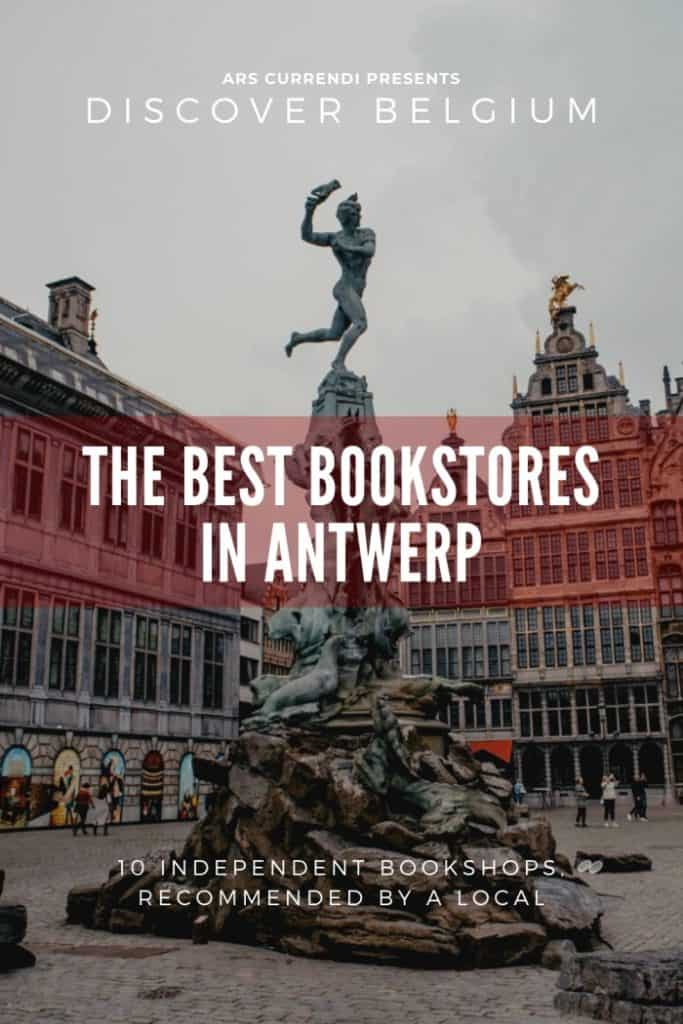
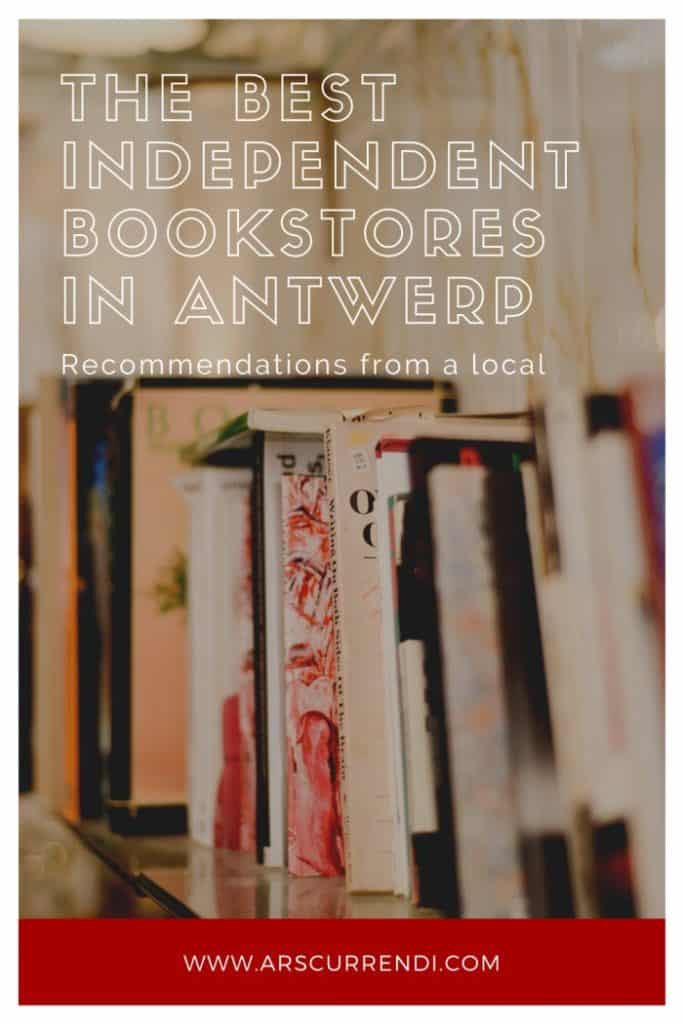
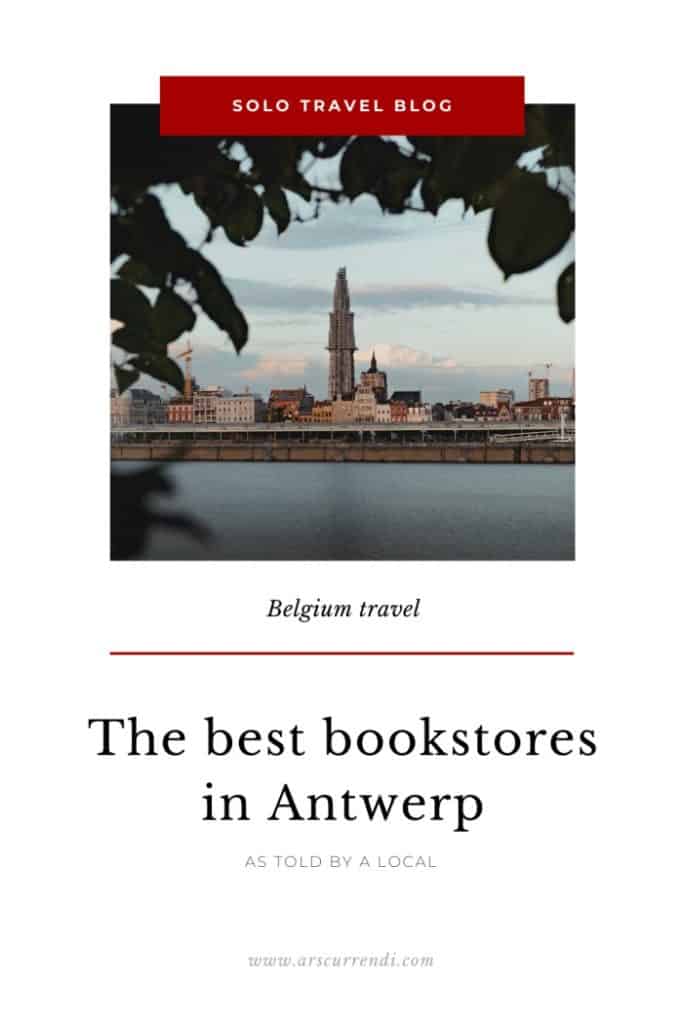
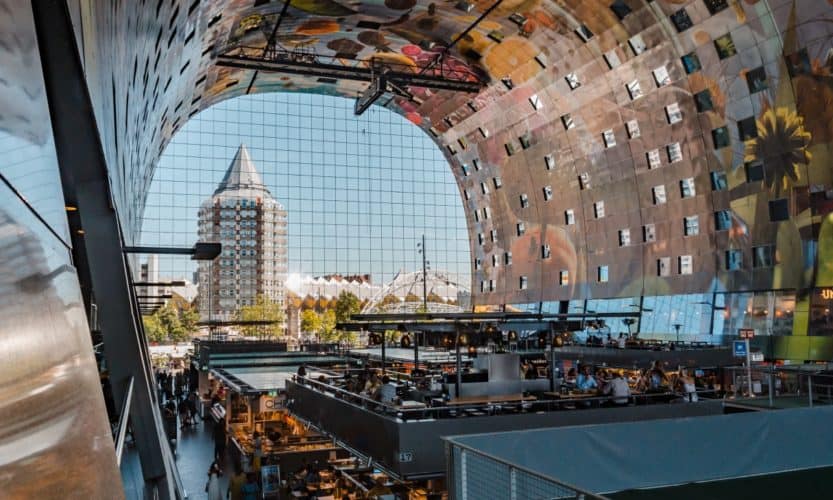
Discover everything the Rotterdam food scene has to offer, from cheap coffee shops to trendy vegetarian restaurants. These are our favourite places to eat in Rotterdam.
Nicknamed ‘Gateway to the World’ thanks to its extensive public transport system, Rotterdam has internationally-inspired eateries sprawled all across town. With plenty of new Rotterdam restaurants and bars opening their doors every day, there has never been a better time to eat out.
In this article, you’ll find well-established institutions and new kids on the block alike. This is the ultimate foodie guide to Rotterdam.
If you’re wondering about my favourite places to eat and drink in Rotterdam, check out the embedded map below (or click the link if the map isn’t showing)
Why don’t you start your journey to Rotterdam by watching my travel video?
Skip ahead with the following links:
Bertmans is a breakfast restaurant in Rotterdam where you can go for a reliable meal at the start of your adventure-filled day.
Bertmans serves both sweet and savoury dishes, with plenty of vegetarian, vegan and gluten-free options for you to choose from.
My personal recommendation: French toast with an iced latte.
Baker & Moore was founded by Paul & Eline, who had always dreamed about starting something and decided to pursue their dream after a round-the-world trip.
At Baker & Moore, you’re in charge. You can assemble a sandwich, salad or yoghurt bowl the way you want to, using their #CreateItYourself formula.
You can come here for all-day breakfast, lunch, or just a drink.
What’s in a name, right? At Bagels & Beans, you can find great bagels, salads, coffee and other drinks at reasonable prices.
Don’t let the fact that this is a chain scare you away. After all, there must be a reason for the company’s success, right?
In the case of B&B, the success is in its simplicity and its accessibility: you can practically find a franchise around every corner in major Dutch cities.
Harvest Coffee Brewers is a place where good food, good coffee and good service come together.
Both founders worked in the Melbourne hospitality industry, where your ability to prepare a great cup of coffee can make or break your reputation. In other words, they know what they’re doing.
At Harvest, they share their Melbourne experiences with the people of Rotterdam, so you may as well enjoy it.
One of my favourite places to get coffee in Rotterdam was Coffeecompany.
If you’re looking for a Starbucks-like coffee chain that’s not Starbucks, Coffeecompany is the place to go for you.
Visiting this place was a part of our morning routine of getting coffee, orange juice and pastries and eating them in our hotel room, and I would highly recommend it.
People with eagle eyes will notice that this is the second time I’m mentioning Baker & Moore.
But I’m the one writing this Rotterdam food guide, so if you have a problem with that, you’re going to have to find a way to deal with it. 🤷
I’m just mentioning them again because they also turn out to have splendid coffee, iced tea and other brunchy drinks.
In its essence, Lilith is a rebellious vegetarian breakfast & coffee place in Rotterdam with a large array of plant-based and gluten-free options.
If you’re looking for great coffee, friendly service and kick-ass American pancakes in an Instagram-friendly interior, you’re not going to find a better spot than Lilith.
Lilith was recommended to me by a friend who’s actually from Rotterdam! If even the locals approve, you’re doing a good job as a restaurant.
Mecca is originally a restaurant that serves some of the best Arabic, Lebanese and Mediterranean food in Rotterdam, consistently recommended by many magazines and bloggers.
But a little-known fact is that the coffee at Mecca is also splendid.
So if you’re in the neighbourhood and you want to unwind, drink some coffee and enjoy the serenity of the surroundings, be sure to pop inside or take a seat on the gorgeous outside terrace.
Markthal isn’t technically a restaurant, but you’ll understand why I put it on this list once you go there.
The best way to describe Markthal I can think of is this: it’s an indoor food court inside a huge dome.
Popular stalls and shops inside Markthal feature authentic food and drinks from all kinds of culture and will give you Dutch stroopwafels, Japanese ramen noodles and Spanish tapas, among many other delicious meals.
Destino is a contemporary Spanish tapas restaurant with a menu that changes every 8 weeks.
If you’re looking for the best classic Spanish dishes with a twist or surprising new Spanish-inspired combinations, look no further than this trendy restaurant, which is located in the up-and-coming neighbourhood Oude Noorden (Old North).
Added bonus: you can find Spanish recipes and an extensive list of tips for restaurants in Spain on Destino’s website.
Op Het Dak is more than a restaurant — it’s an experience.
At a ten minute walk from the central station, you’ll find the first rooftop farm and urban garden of Holland. Attached to this is a place where you can have breakfast and lunch, with a focus on clean, simple and local food.
The menu is mostly vegetarian, but there is also a daily catch of fish that the chef transforms into a lovely meal. My personal recommendation is the courgette shakshuka.
Little V is a franchise of restaurants serving traditional Vietnamese food in the Netherlands, located in Rotterdam and The Hague.
The first Little V restaurant was launched in The Hague in 2006, as a way to introduce Dutch people to South Vietnamese food. Fourteen years later, this restaurant is still going strong, and the chain is doing better than ever.
One of the reasons why Little V works so well is because of its focus on shared eating: you order a few dishes, place them in the middle of your table and share them with friends and family.
Without a doubt, dining at Zino Urban Bistro was my most interesting experience in Rotterdam. The only thing you can order at Zino is a surprise menu of 3, 4 or 5 courses.
The contents of the menu change every week, but it’s always based on French cuisine. Of course, if you have dietary restrictions, just tell the waiter and you’ll get an adapted menu.
The food here was magnificent. Surprising combinations, innovative techniques and wonderfully attentive staff made sure that Zino became one of my favourite restaurants in Rotterdam.
While most restaurants in Rotterdam have at least a few vegetarian-friendly options, there are some restaurants that go the extra mile and are dedicated to the veggie lifestyle. Here are my favourites vegetarian restaurants in Rotterdam.
The main reason why Rozey is one of my favourite places to eat in Rotterdam is because you barely even notice that you’re not eating meat.
The concept is simple: you pay a set price and you get to order delicious vegetarian food to your heart’s content. (And yes, drinks are also included in the price.)
Be sure to try out the feta rolls and the fried sweet pepper.
At Sugo Pizza, the star of the show is their famous pizza al taglio – pizza baked in large rectangular trays, and sold by the square.
Granted, not all pizzas at Sugo Pizza are vegetarian, but they have plenty of veggie-friendly options.
Okay, so get this. Contrary to popular belief, junk food doesn’t have to be meaty. Whoa. I know. And, hold on to your hats, Vegan Junk Food Bar proves that vegan food can be delicious.
Not only that, but the food is also incredibly Insta-worthy (as their 80K+ Instagram followers will testament).
Cruelty-free plant-based burgers? Loaded kapsalon fries? Flashy cocktails? Find all of this – and more – at Vegan Junk Food Bar.
Aloha markets itself as a ‘low waste foodbar’, but it’s actually much more than that. It used to be a subtropical swimming pool, until it was converted into the trendy restaurant it is today.
Aloha is on a mission to serve slow food with unique combinations of surprising ingredients and to reduce food waste. And while that’s a great mission to stand behind, there’s one thing about Aloha I love more.
The rooftop terrace. The atmosphere here is unlike anything I’ve experienced before and the view of Rotterdam’s harbour is to die for. But I guess you’ll have to see it yourself to believe me.
As a Belgian travel blogger, I can’t help but feel drawn to a place called ‘Belgian Beer Café Boudewijn’. I just can’t help it.
This bar combines the brilliance of Belgian beers with the hospitality that Rotterdammers are known and loved for.
At Boudewijn, you’ll find 24 splendid Belgian beers on tap and over 200 bottled beers. Or, as we call it in Belgium, just enough to have a bloody good time.
Related: 20 Cities In Belgium Worth Exploring
One of the best places to get a drink in Rotterdam is called Bokaal. A trendy city café in the newest cool neighbourhood in Rotterdam, Bokaal has something for everyone.
Whether you’re a beer connoisseur, a freelancer looking for a place to work for a few hours or just someone who wants to get tipsy with friends, Bokaal is the place to be.
Thoms is one of those places in the city where you can spend an entire day without getting bored.
It’s a coffee bar, restaurant, café, terrace and nightclub all rolled into one fabulous establishment in the heart of Rotterdam.
At night, the underground bar magically transforms into a nightclub where you can move to the beats until the early hours.
By now, surely, you’ve realised that there’s something for everyone in this city. They don’t call it the New York of the Netherlands for no good reason, right?
So, now that you know where to eat and drink in Rotterdam, there’s nothing left for me to do than wish you the very best on your trip.
Do let me know if I missed anything or if you went to one of these places and loved it just as much as I did.
PIN IT!
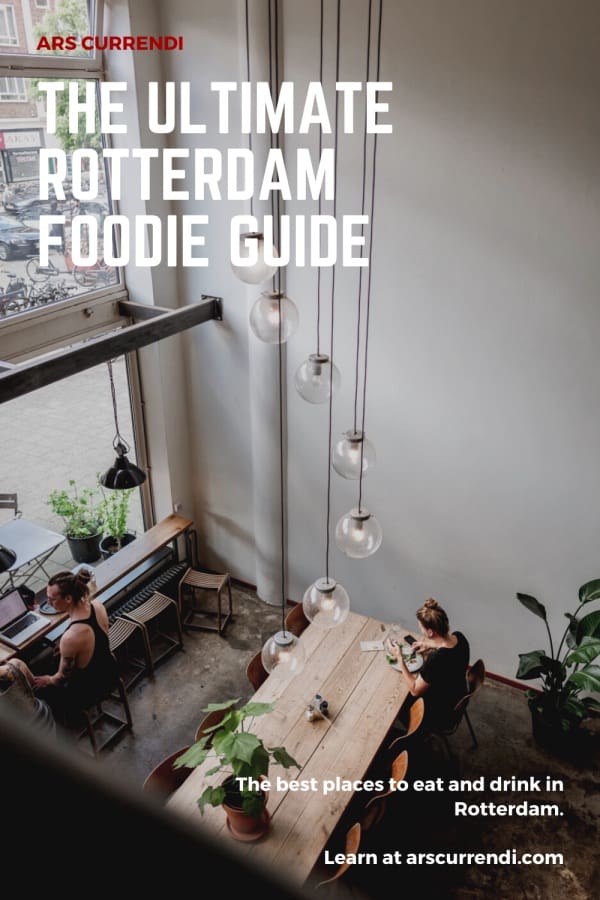
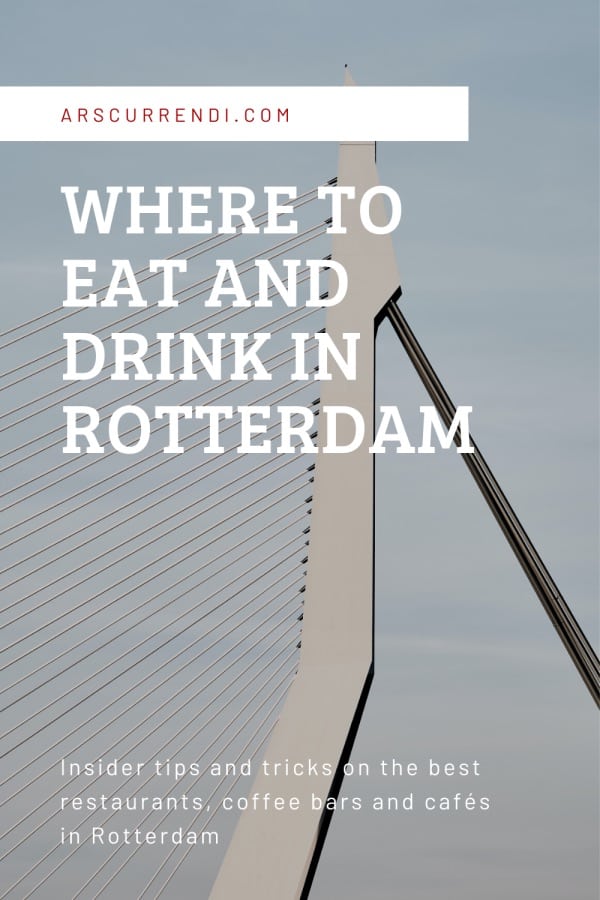
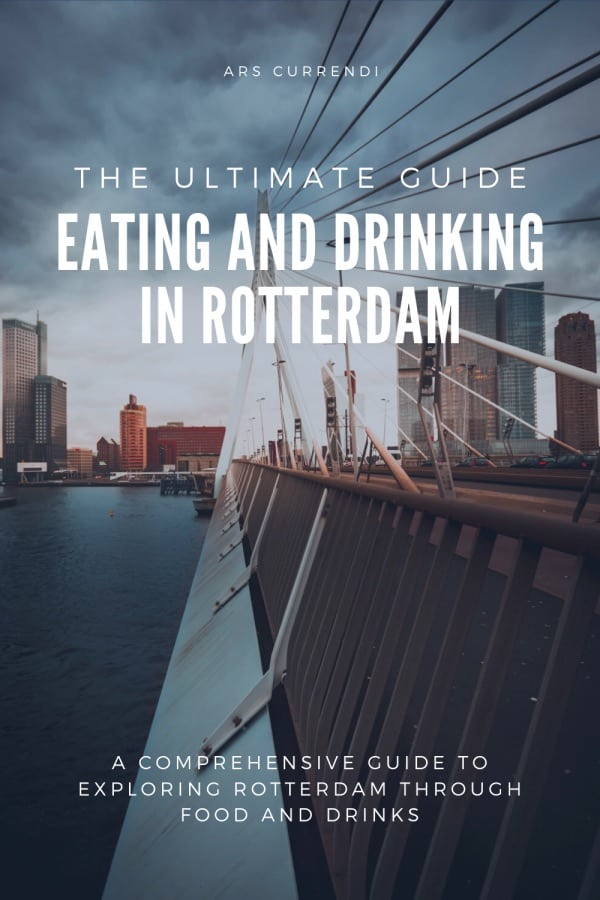
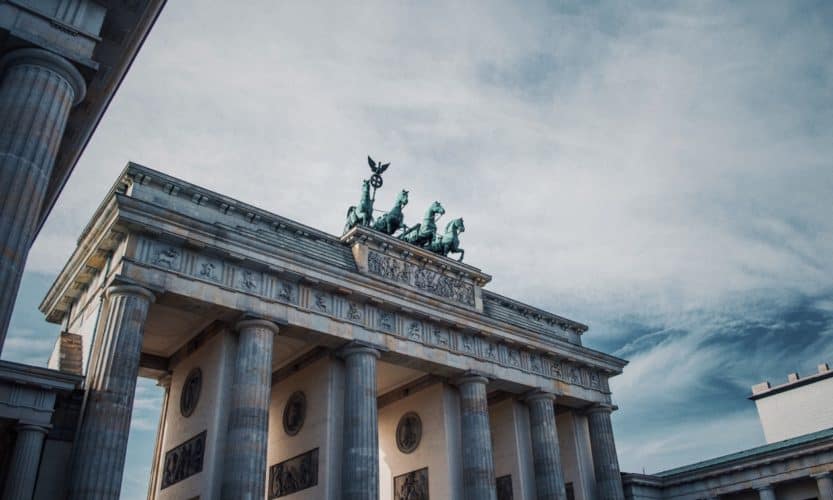
Berlin is the EU’s biggest city and the capital of Germany, and while that may lead you to believe that it will be expensive to visit, nothing is further from the truth. There are plenty of free things to do in Berlin, and I’m here to show them to you.
Before you go any further, take a look at my 3-day Berlin solo itinerary.
Now, let’s take a look at those free Berlin activities!
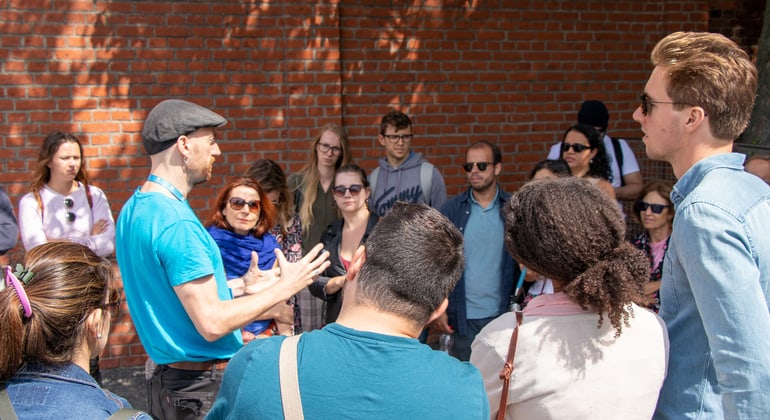
One of my favourite free things to do in Berlin — or in any city, for that matter — is to join a free walking tour.
These tours are usually guided by locals, who will show you things you’ll never find in the guidebooks.
And the best part is, there are so many different kinds of free walking tours in Berlin that you’ll be sure to find something you’re interested in.
Street art? Berlin highlights? Cold War? Whatever it is you’re looking for, chances are you’ll find it in Berlin.
Do keep in mind that free walking tours are often tip-based, meaning that they won’t be completely free.
Tempelhof was Berlin’s main airport until 2008, when it was closed and flights started operating from the city’s other airports, Tegel and Schönefeld, instead.
Today, Tempelhof Field (the runway and its surrounding area) have been converted to a public park where locals go jogging or rollerskating, or even share a picknick on a warm summer day.
More information: Tempelhofer Feld
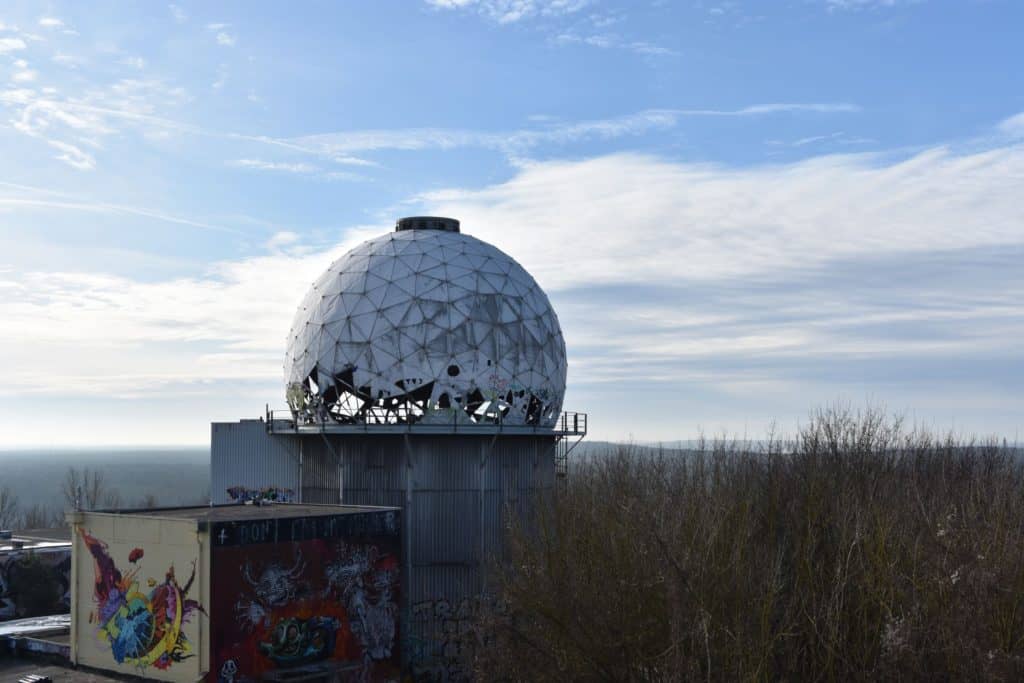
One of my favourite things to do in Berlin – as in any other city, to be honest – is to find some little-known, abandoned buildings and explore them. And, as you might have guessed, Teufelsberg is one of those.
Related: Why I visited an abandoned children’s hospital in Berlin
Teufelsberg is an abandoned spy station on a man-made hill, which has been turned into a street art sanctuary.
You’ll have to face a little bit of a hike (which took me about 30 minutes) and there’s a small fee (€5,50) to enter the grounds, but it’s more than worth it.
Insider tip: don’t bother trying to find a way to climb the towers and get to the domes. It can’t be done, unless you want to risk your life.
More information: Teufelsberg
If you’re ever looking for free things to do in a new city, a safe bet is always to find a cool neighbourhood and walk around for a few hours.
In Berlin, one of those neighbourhoods is Bergmannkiez, a small area in the southern part of the city with charming cobble-lined streets and unique shops and bars to explore.
Some possible highlights for your visit to this area are the Marheinekeplatz flea market, Another Country bookstore, PICKNWEIGHT vintage kilo store and Marheineke Markthalle.

The East Side Gallery is, without a doubt, one of the most popular and best free things to do in Berlin.
As you may or may not know, the East Side Gallery consists of a series of graffiti murals painted directly on remnants of the Berlin Wall.
Fun fact: with its length of 1,4 km, the East Side Gallery is often considered to be the world’s biggest (and longest-standing) free open-air art gallery.
More information: East Side Gallery
As a city that flawlessly combines historic facades and futuristic buildings, Berlin has plenty of impressive architecture for you to discover.
So why not organise your own self-guided architecture walk?
For the specifics on what to see on your walk, I’ll let Julie from The Gap Year Edit do the talking in her article (linked below).
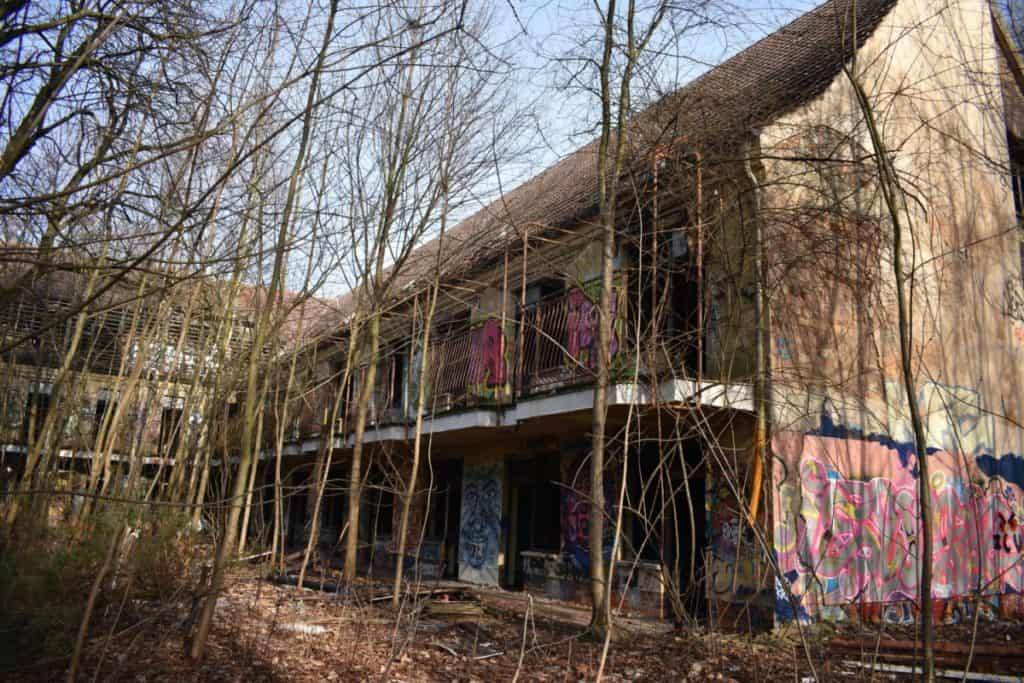
Yeah, I know. It’s a little out there. When you’re looking for free things to do in and around Berlin, your mind probably doesn’t race to an abandoned children’s hospital.
But you should at least consider it.
I did it when I was travelling solo in Berlin, and it turned out to be one of the most exciting things I did there.
(It was also one of the scariest things I’ve ever done, but let’s not talk about that right now)
Here’s some more information about how I did it, and how you can do it too:
Arts and culture are a very popular area for many cities regarding free things to do. Of course, Berlin is no different.
One of my favourite artsy spots in the city is Urban Spree, a free gallery where exhibitions, workshops, concerts and live events take place.
The exhibitions on display at Urban Spree feature contemporary art by modern artists – both German and international – and usually run for about one month.
More information: Urban Spree

The Holocaust Memorial is one of the most-visited monuments in Berlin, and for good reason.
This elegant installation serves as a humble reminder to the millions of murdered Jews and their suffering in concentration camps in and around Germany during World War II.
Additionally, an underground information centre holds the names of over 3 million Jews who lost their lives in the Holocaust.
More information: Memorial to the Murdered Jews of Europe
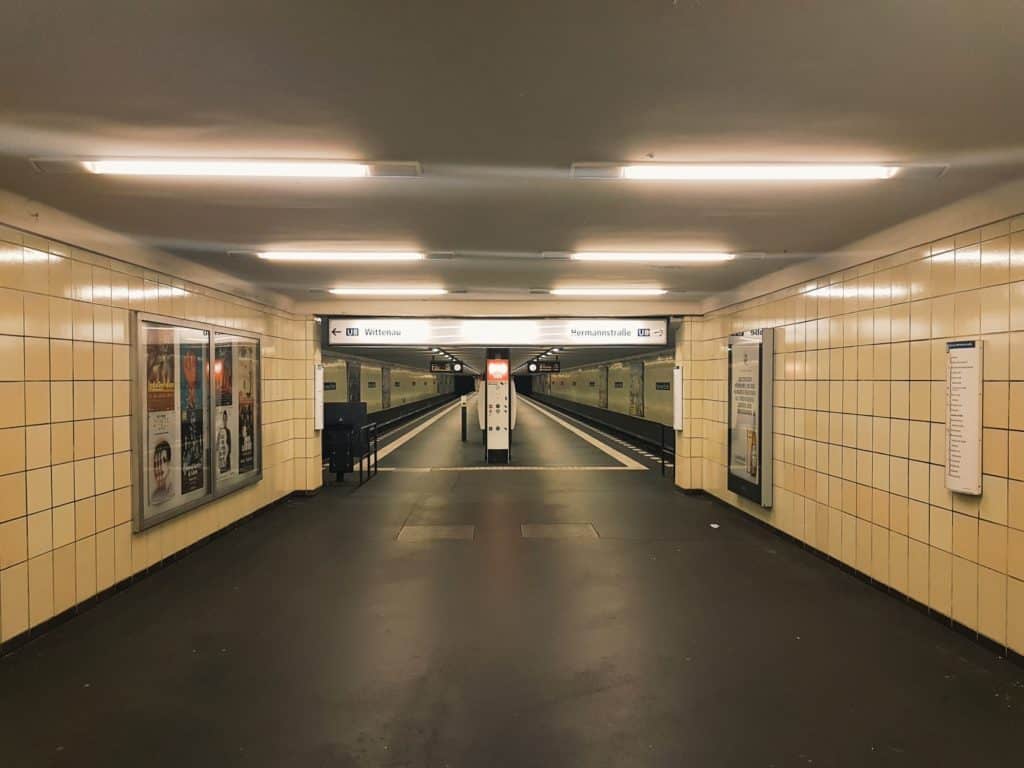
One of my favourite free things to do in any destination is just walking around without having a specific destination in mind.
Let the cobbled streets envelop you, lose yourself in tight alleys and big shopping streets. Take in the atmosphere.
It doesn’t have to be a whole day, either. Just take an hour or two and go where the wind takes you. You’d be surprised at what you’ll discover.
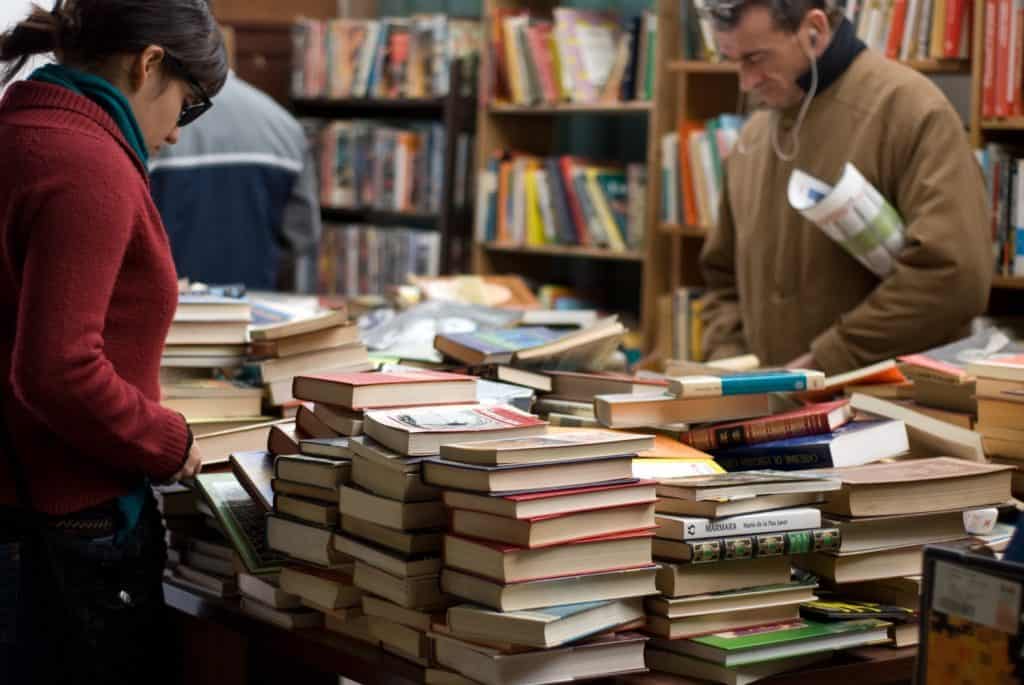
If you’re someone who gets joy out of hunting vintage posters, collecting stamps or hoarding war memorabilia, Berlin really is the place to be.
Since the city’s flea market culture is hardly a secret, you could possibly spend your entire holiday in Berlin browsing its many flea markets.
The biggest and most famous flea market in Berlin is at Mauerpark, but that’s definitely not the only one worth checking out.
Read this article about nine awesome flea markets that aren’t Mauerpark by the people from EXBERLINER.
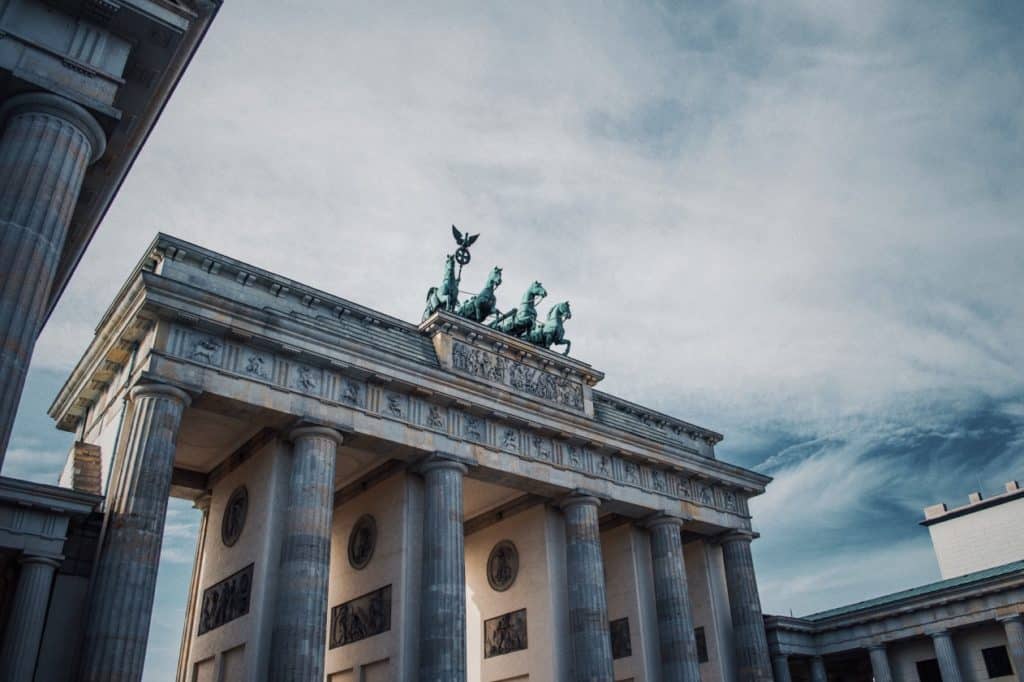
For architecture and history nerds, monuments like the Brandenburg Gate (Brandenburger Tor in German) are a sight to behold.
Constructed in 1791 on the orders of Prussian king Frederick William II, it has been the scenery for many significant events from German history.
Today, the Brandenburg Gate is considered a symbol of both the stormy history of Germany and Europe and unity and peace across the European continent.
More information: Brandenburg Gate
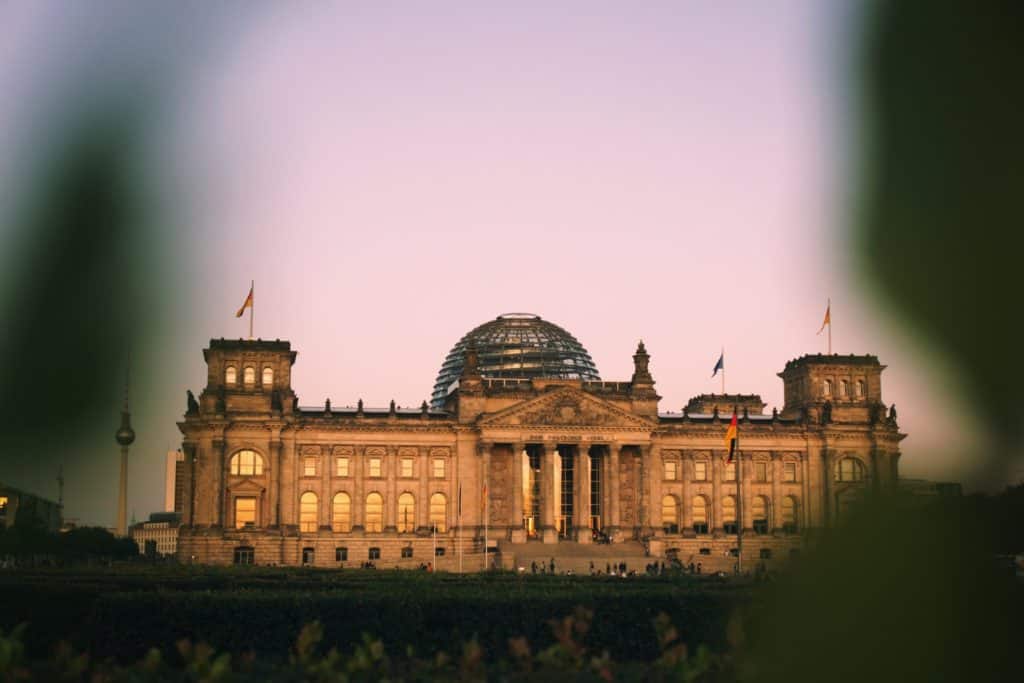
One of the city’s most historically significant buildings is the Reichstag, which has housed the German parliament since 1999.
The building stands steady in the Berlin skyline as a symbol of European and German democracy.
For visitors, one of the most interesting things to do is to climb up to the roof of the Reichstag building and enjoy the free panorama. Keep in mind that you have to register online to climb the building. (But it’s completely free!)
More information: Reichstag Building
Berlin’s Museum Island (Museumsinsel in German) is home to five museums, where you can find impressive collections besides the eye-catching exteriors of the buildings.
Unfortunately, you’ll need to purchase a ticket to actually get into the museums, but you can freely walk around Museum Island without a ticket.
One ticket costs €19 (€9,50 for reduced price tickets) and will get you into the following museums:
More information: Museum Island
Given its status as one of the most-visited war-related places in Berlin, Topography of Terror is definitely a documentation centre worth visiting.
The aptly-named Topographie des Terrors exhibition serves as a humble reminder to the terrors of the Second World War, including information about the Gestapo, the SS and the Reich Security Main Office.
Admission to the site is free and every exhibition is fully accessible for people who use wheelchairs.
More information: Topographie des Terrors
Note: the information in this post is loosely based on a Twitter thread with free things to do in Berlin that I made last year, just after I came back from my own trip to Berlin.
PIN IT!
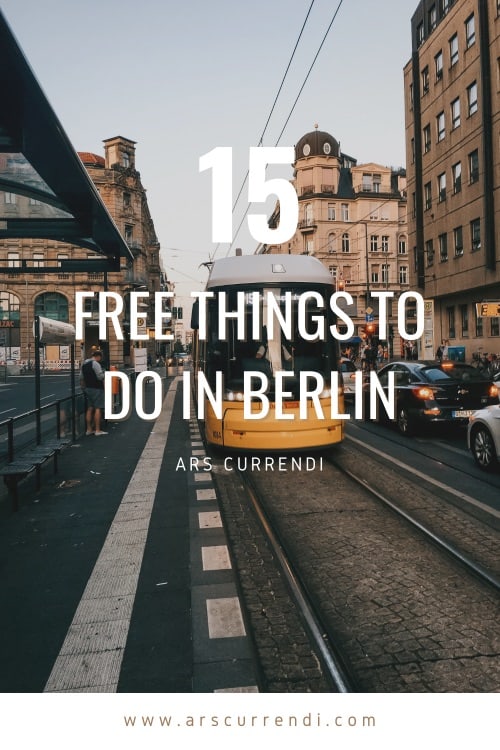
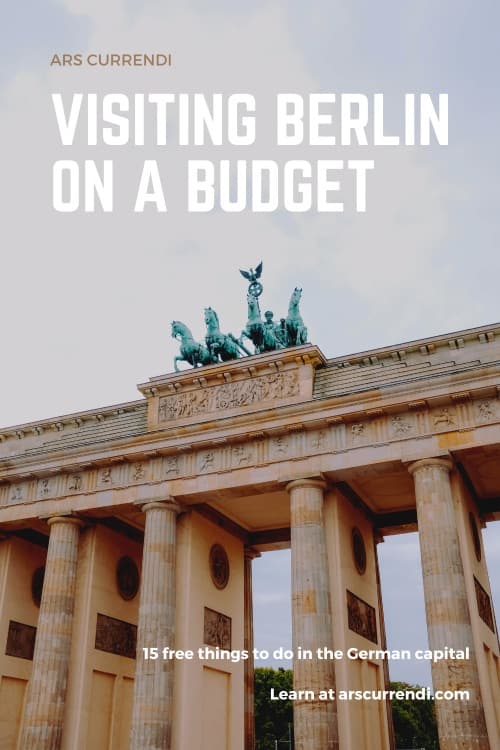
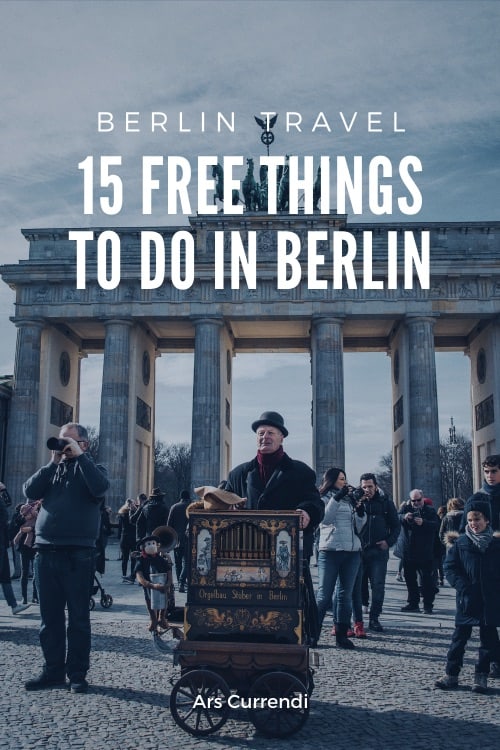
Design by NXNW.